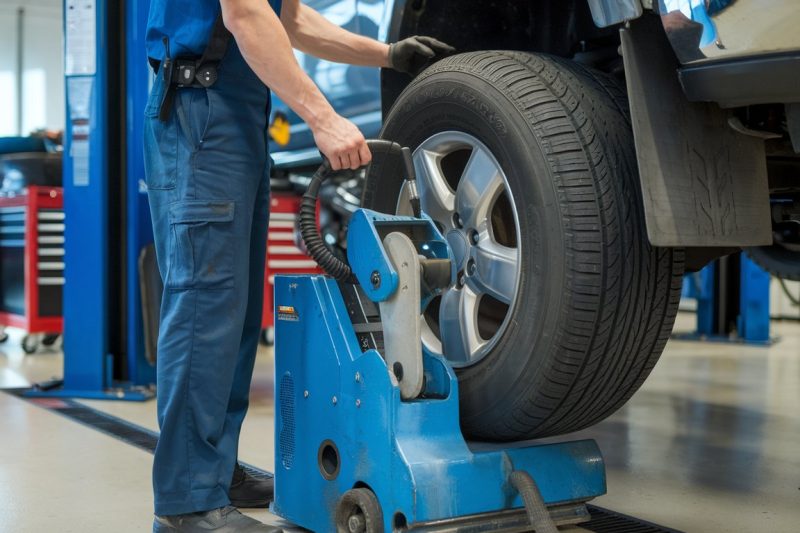Tire rotation is a crucial but often overlooked aspect of car maintenance. It involves periodically changing the position of each tire on your vehicle. This ensures that your tires wear evenly over time. This simple practice can enhance your car’s performance and save you money in the long run.
When tires wear unevenly, they can affect your car’s handling, fuel efficiency, and safety. Uneven wear occurs because each tire supports different loads and experiences varying road conditions. By rotating your tires regularly, you distribute the wear more evenly across all four tires. This extends the life of your tires and helps maintain your car’s balance and stability.
Proper tire maintenance, including regular rotations, is key to ensuring that your vehicle runs smoothly. Ignoring tire rotation can lead to a range of issues that can compromise your driving experience and safety. Understanding why tire rotation is important can help you make informed decisions about your car’s upkeep and keep you safe on the road.
Understanding Tire Rotation: What It Is and Why It Matters
Table of Contents
- 1 Understanding Tire Rotation: What It Is and Why It Matters
- 2 Benefits of Regular Tire Rotation
- 3 Signs Your Tires Need Rotation
- 4 How to Maintain a Regular Tire Rotation Schedule
- 5 Save Money and Stay Safe: Don’t Skip Tire Rotations
- 6 What is the importance of tire rotation and Why?
- 7 How often should I rotate my tires?
- 8 What happens if I don’t rotate my tires?
- 9 What is the best tire rotation pattern?
Tire rotation is moving the tires from one position on the vehicle to another. This usually involves switching the front tires to the back and vice versa, and sometimes swapping the left and right ones.
Doing this regularly ensures that all four tires wear down at the same rate. This is essential because tires wear differently depending on their position and weight. For example, the front tires on a front-wheel-drive car will wear out faster because they handle most of the driving force and steering duties.
Even tire wear is crucial for maintaining your car’s balance and handling. Uneven tire wear leads to various problems, including vibrations, poor traction, and decreased fuel efficiency.
Uneven wear can also cause your tires to fail prematurely, which could be dangerous and costly. Regular tire rotations help maintain a smoother, safer ride by ensuring that your tires degrade evenly over time. This practice extends the life of your tires, provides a more comfortable driving experience, and keeps your vehicle handling as it should.
Benefits of Regular Tire Rotation
There are many benefits to rotating your tires regularly. First, it extends the lifespan of your tires. Since tire rotation ensures even wear, you won’t need to replace your tires as frequently. This can save you a significant amount of money over the life of your vehicle. Even wear also means that all of your tires will have better traction and performance, which is essential for safety, especially in adverse driving conditions like rain or snow.
Another significant benefit is improved fuel efficiency. When your tires wear unevenly, your car’s engine has to work harder to propel the vehicle forward. This extra effort consumes more fuel, reducing your gas mileage. By rotating your tires, you ensure they wear evenly, which helps maintain optimum fuel efficiency.
Regular tire rotations can enhance your car’s safety. Unevenly worn tires can lead to poor handling, increased stopping distances, and a higher risk of tire blowouts. Keeping your tires rotated helps your car perform better and keeps you safer on the road.
Signs Your Tires Need Rotation
It’s important to recognize the signs that your tires need rotation to maintain optimal vehicle performance. One of the most common signs is uneven tire wear. If you notice that the tread on some tires is significantly more worn than on others, it clearly indicates that they need to be rotated. You can check this by visually inspecting the tires or using a tread depth gauge to measure the depth of the tread.
Another sign is if your vehicle vibrates while driving. Uneven tire wear can lead to an imbalance, causing vibrations that you’ll feel in the steering wheel or throughout the car. This can occur even at low speeds and becomes more noticeable as you drive faster.
Additionally, if you hear unusual noises coming from your tires or notice that your car is pulling to one side, it could mean your tires are wearing unevenly and need to be rotated.
How to Maintain a Regular Tire Rotation Schedule
Maintaining a regular tire rotation schedule is easier than you might think. One practical way to stay on top of tire rotations is to keep a log of your vehicle maintenance. Write down the date and mileage every time you rotate your tires. This helps you track how long it’s been since the last rotation and when the next one is due. Many experts recommend rotating your tires every 5,000 to 8,000 miles, but you should always follow your vehicle manufacturer’s guidelines.
Regular tire checks during routine maintenance visits are also essential. Professional mechanics can spot uneven wear and other issues that may indicate the need for rotation. They have the experience and tools to ensure your tires are rotated correctly and that your vehicle maintains its performance and safety.
By combining professional service with personal vigilance, you can maintain an effective tire rotation schedule and keep your vehicle in excellent condition.
Save Money and Stay Safe: Don’t Skip Tire Rotations
Regular tire rotation is key to extending the life of your tires, improving fuel efficiency, and ensuring a safe driving experience. By understanding the importance of even tire wear and recognizing the signs that indicate the need for rotation, you can avoid many common issues that affect your vehicle’s performance. Keeping up with a regular tire rotation schedule is a simple yet effective way to maintain your car’s health and save money in the long run.
Don’t overlook this essential aspect of car maintenance. Stop by My Mechanic Joe to schedule your tire rotation and keep your vehicle running smoothly. Our expert mechanics are ready to help you with all your auto repair and maintenance needs in Woodstock!
What is the importance of tire rotation and Why?
Tire rotation is the practice of moving the tires of your vehicle to different positions, typically from front to back and sometimes switching sides, to promote even tire wear. Regular tire rotations are important because they can extend the life of your tires by ensuring that all four tires wear evenly. This process mitigates the risk of uneven tread wear, which can lead to premature tire failure and safety issues, such as a tire blowout.
How often should I rotate my tires?
Most manufacturers recommend that you rotate your tires every 5,000 to 7,500 miles, coinciding with regular vehicle maintenance tasks like an oil change. However, the exact frequency can depend on your vehicle’s specifications, the type of tire, and your driving habits. If you frequently drive in extreme conditions or have a front-wheel-drive vehicle, you may need to get your tires rotated more often.
What happens if I don’t rotate my tires?
If you neglect to rotate your tires, you may experience uneven tire wear, which can lead to a significant reduction in the life of your tires. This can also affect your vehicle’s handling, increase fuel consumption, and put you at a higher risk for a tire blowout. Ultimately, failing to get your tires rotated could result in a need for premature tire replacement, costing you more money in the long run.
What is the best tire rotation pattern?
The best tire rotation pattern depends on the type of drivetrain your vehicle has. For front-wheel drive vehicles, a common pattern is to move the front tires to the back and switch sides, while the rear tires move to the front in a straight line. For rear-wheel drive vehicles, the opposite applies. If your vehicle has all-wheel drive, a cross-rotation pattern might be recommended. Always consult your vehicle’s manual for the recommended

